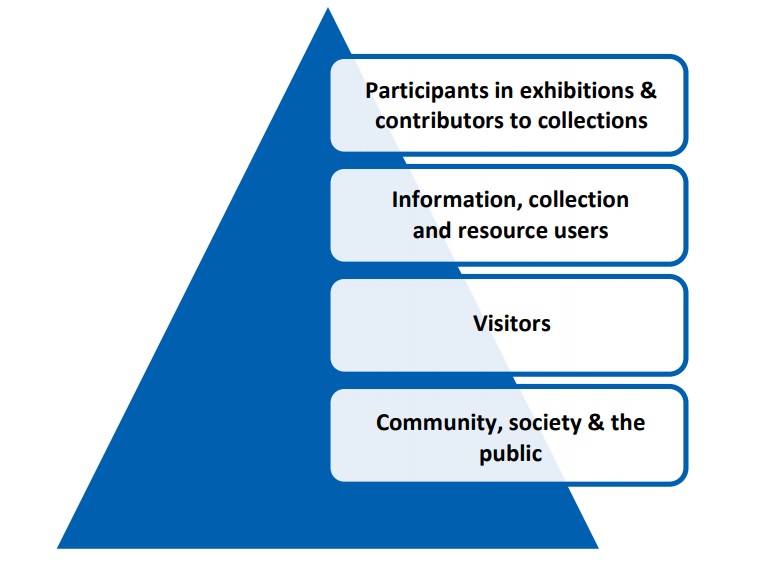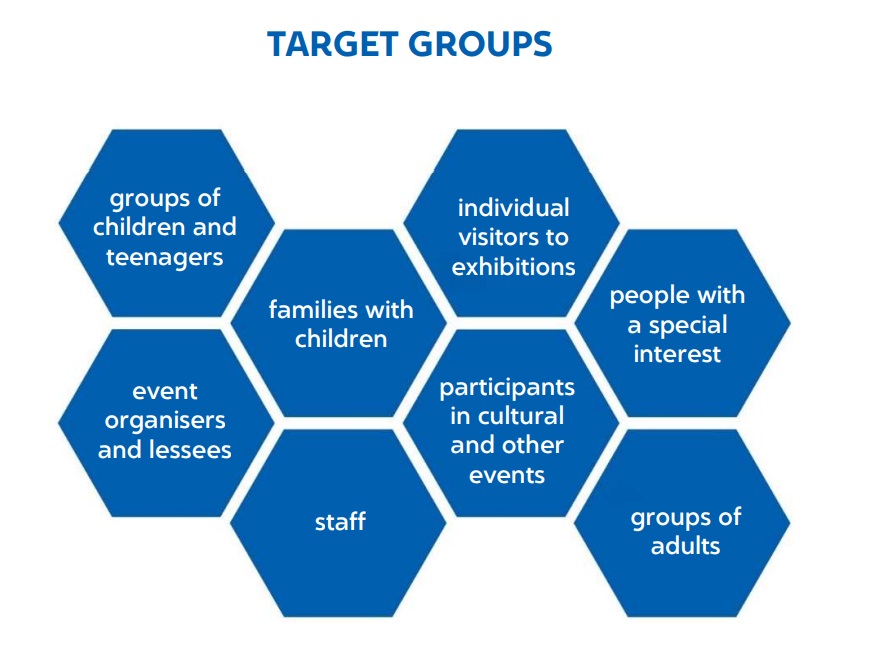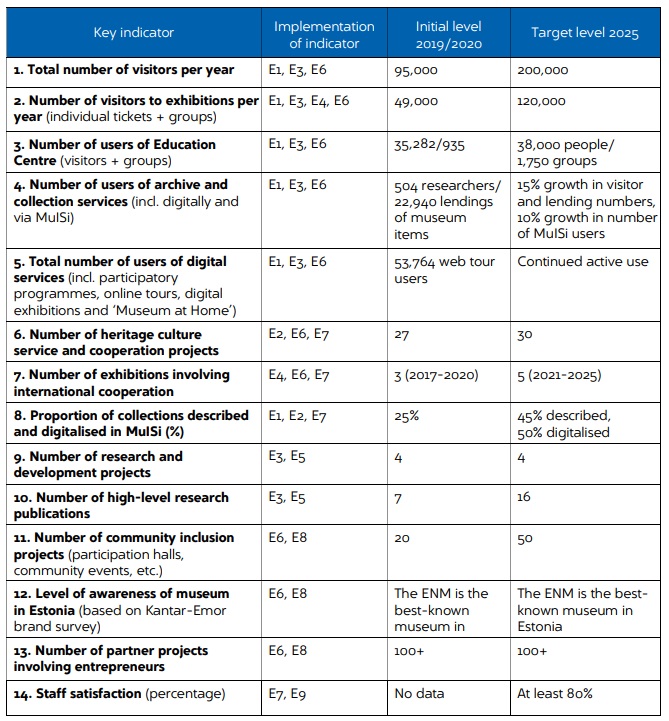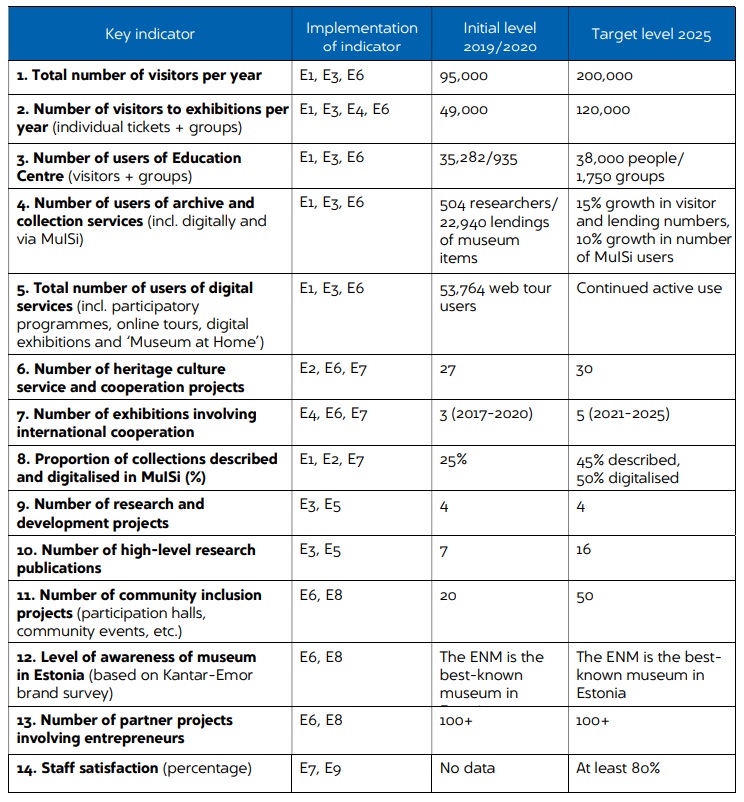Development plan
ESTONIAN NATIONAL MUSEUM
DEVELOPMENT PLAN
2021-2025
DEVELOPMENT PLAN
2021-2025
1. Preface
The Estonian National Museum (ENM) has adopted a new development plan. This means that the members of the museum family have agreed on shared objectives and directions for development. The goal which the ENM sets in its plan is to serve as a museum for the entire nation, being open and flexible and an influential voice in Estonian society.
In addition to what has already been done, over the next few years attention will have to be turned and effort directed towards achieving the broader independence and decision-making rights of the museum, even more openness and community inclusion and improved access to cultural heritage. The principles of a sustainable living environment are also important.
The overall objective of the ENM is to retain and strengthen its position as an event and cultural centre of national and international significance.
As a result of its intention to serve both the state and its people, the ENM continues to have special obligations regarding the conservation and study of folk culture. Alongside this, the museum has tasked itself with achieving even greater visibility on the international museum scene by acting as a partner on a range of cooperation projects. For all of this to be implemented in reality, the museum needs to be a modern, pro-active organisation.
The development plan is by no means final, but simply outlines the current trends and developments in the museum, which will be reviewed as circumstances change. Constantly striving to achieve our goals will help us reach the targets set out in the plan.
Alar Karis
Director
Director
2. Mission
The mission of the ENM is to preserve the culture, identity and memory of Estonia and all Finno-Ugric peoples, to give meaning to heritage and to build bridges in society.
3. The Estonian National Museum in 2025
-
The ENM is an open and inclusive cultural environment which creates value.
-
The ENM is an influential centre of culture, education and research with an international reach.
-
As an institute preserving and giving meaning to heritage, the ENM broadens the scope of public debate.
4. Core values
In acting to achieve the ENM’s vision and development goals, we observe shared values and follow them in our everyday operations. These values reflect the identity of the museum and contribute to its smooth running.
- Cooperation | We are friendly and trustworthy partners who take others into consideration not only within our organisation, but within our community and in museum and research circles in Estonia and abroad. We focus on solutions, guided by the tenet that it is always possible to find ways of doing things rather than getting bogged down in why something cannot be done.
- Openness | Everything the museum does is aimed at the public, getting the community involved and offering value to all. We take both individual needs and the needs of society into account, implement the latest museum practices and are open to ideas and initiatives.
- Consistency | We maintain the focus that derives from our mission and consistently preserve and generate traditions, customs and other values. We offer everyone the opportunity to participate in documenting, giving meaning to, passing on and recreating everyday cultural history that is diverse and open to interpretation.
- Professionalism | The museum is home to a dedicated team of professionals. Our activities and information aimed at the public are honest, ethical and based on knowledge and expertise, creating value in society.
5. A museum for the entire nation
Based on its mission, the ENM is at the service of society and of each and every one of its members individually. The museum exists and operates for the public. Its task is to ensure that all social groups are able to enjoy what the museum has to offer without let or hindrance – be such obstacles intellectual, cognitive, physical or digital.
In order to be able to offer a high-quality service that meets people’s needs and expectations and creates value, we must understand what makes visitors and other target groups unique and shape our offering such that it is suited to the specific group.
Based on intensity of contact, we define the ENM’s main target groups as follows:

Based on needs, the most important target groups are:
- individual visitors to exhibitions with an interest in culture;
- families with children;
- groups of children and teenagers who visit exhibitions and take part in educational programmes;
- groups of adults, such as those whose visits are arranged by tourism companies or colleagues on company outings;
- people with a deeper special interest, such as researchers, students, scientists and handicrafts specialists;
- people who attend or take part in conferences, cultural events and other events at the ENM;
- event organisers and those who lease space in the museum or on the premises; and
- the target group within the museum itself, i.e. its employees.

The activities of the ENM are influenced by its main interest groups, the parties representing which are the state (via the Ministry of Culture and the Ministry of Education and Research), local governments (the City of Tartu and Tartu and Viljandi municipalities), other memory institutions, organisations promoting the internationalisation of Estonia and international organisations (incl. ICOM). Their support and cooperation are needed for the museum to survive and thrive.
6. Strengths and development needs
6.1.Strengths
The strengths of our organisation must be upheld in every way possible – they help us make the most of the development opportunities that come our way and follow the museum’s vision. In the main, our strengths are:- wide-ranging knowledge and competence, internationally recognised museum workers and qualified support staff;
- extensive collections (incl. unique ethnology collections) and more than 100 years of experience and competence in working with collections;
- a strong, positive image among people living in Estonia as a museum and as a preserver and promoter of what it means to be Estonian and of Estonian and Finno-Ugric cultural history through world-class exhibitions and research, education and programme activities;
- functioning not only as an event centre, a provider of diverse programmes and a meeting place, but as the focal point of culture in Tartu and Estonia as a whole;
- our multifunctional museum building, renowned for its architecture, boasting first-rate infrastructure and offering outdoor areas with a wide range of uses; and
- our ability to devise and organise high-level exhibitions and events with a variety of additional services.
6.1.Development needs
The museum’s development needs stem from self-analysis, the outcomes of our previous development plan and the development vision we have set for ourselves, in accordance with which the ENM sets goals for the next period of the development plan.
- We must determine in greater detail and agree on the content, scope and objectives of research work and place greater importance on collection-based research, adding to our collections as a result. In terms of museum practices, the ENM aims to boost its role, increasing its competence as a centre of excellence in order to share the latest museum knowledge and skills with other memory institutes as a guide and mentor.
- Of key importance are supporting and ensuring the continued motivation of museum staff, creating development opportunities for museum specialists, fostering subject-specific knowledge and skills, supporting the next generation of museum workers and guaranteeing the staff needed for the fulfilment of duties. In addition to cultural workers, we pay attention to those who offer additional services at the ENM so as to instil in them more of a sense of being part of the museum family and sharing in the responsibility this entails.
- In terms of exhibiting, we need to update our permanent exhibitions so as to encourage people to regularly revisit them. Our aim is to undertake more international cooperation so as to bring high-quality travelling exhibitions to the museum and to produce internationally touring exhibitions ourselves. In producing exhibitions, we must take cost-effectiveness into account alongside content. Departments need to work together to put in place an exhibitions policy and five-year plan in line with the needs and expectations of society so as to ensure long-term operating prospects for workers.
- The role of the ENM as a museum for the entire nation is to generate stronger links between folk culture, ethnic studies and social challenges, to bridge the heritage gap between past and present and to give meaning to heritage as a whole. We need to reflect more what is happening in society and open up discussions to contribute to the creation of a more cohesive society.
- In regard to the image of the museum and its visitor numbers, it is important that the ENM be a museum for the entire nation at which everyone feels that the museum is for them. We must analyse the expectations of social groups and of people residing in different cultural spaces, as well as the obstacles and restrictions they face in visiting the museum. The messages and channels we use for communication should be based thereon.
- More effort needs to be put into teamwork, the exchange of information, management of specific areas and cooperation in setting and fulfilling shared goals. In order to achieve the museum’s objectives and to secure more systematic cooperation, restructuring will be undertaken within the organisation.
- In the operations of the museum it is important to bear in mind that activities are in line with the changing expectations of target groups and to take into account the digitalisation of society. Digital solutions which support the content work of the museum and give consideration to the individual preferences of visitors and users must be developed, and the ease of use of such solutions must be improved. It is important that we find ways of offering such solutions that allow us to generate revenue.
- To guarantee the sustainable development of the ENM and to more precisely determine its operating limits and possibilities, we must achieve clarity and agree on the principles of the museum’s legal form, research institute status and financing as quickly as possible.
- The additional services offered by the museum play a significant role from the point of view of the ENM as a cultural centre and the inclusion of a broad-ranging audience, and are largely responsible for determining the financial sustainability of the museum. In designing and offering additional services, we must be guided by our mission and values and ensure that such services support the provision of our main services and enrich the museum experience to the maximum extent.
- In developing the museum premises, both indoors and out, we must bear in mind the optimal, multifunctional use of the spaces and how environmentally friendly they are, taking all ages into account to guarantee the best access for visitors (incl. those with special needs). Access to the museum and services must be made even more convenient and visitor-friendly, incl. for those travelling to the museum on public transport. Staff working spaces and all repositories must be brought into line with the required conditions. A use suited to the content and current design of the ENM must be found for the protected Raadi Manor complex. The concept of the park needs to be updated and all planned developments implemented.
- Cooperation with partners in regard to main services and in the fields of the creative economy, tourism and the organisation of culture (incl. opening up international cooperation) is important to the ENM.
- Both the Heimtali Museum and Anu Raud’s heritage collection need to be better integrated and showcased.
- It is important that we act to achieve greater dialogue and ties with the Tartu community and reaffirm, as part of the image of the museum, the understanding that the ENM is the centre of the rich cultural space of Tartu, incl. in connection with the ‘Tartu – European Capital of Culture 2024’ programme. The message that the museum is just a pleasant stroll from the city centre needs to be heard more, especially among our target groups (incl. among the people of Tartu).
7. Strategic goals 2021-2025
In setting ourselves objectives, we are guided by the museum’s mission and future outlook.

8. Key indicators and target level of development
The achievement of the ENM’s development objectives is measured using key indicators as part of annual or periodic monitoring. The indicators derive from the museum’s mission, vision and goals and from national guidelines. They help us keep track of the results of planned activities and how effectively we are moving towards our goals.

9. Strategic framework influencing operations
The operations of the ENM accord with the museum’s statutes, the Museums Act, other national documents regulating the field of culture and the ICOM Code of Ethics for Museums.
-
ICOM Code of Ethics for Museums
-
Museum Act
-
Cultural Development Plan 2021-2030
-
Tartu Development Strategy 2030
-
Tartu Development Plan 2018-2025
-
Tartu Municipal Development Plan 2018-2030
-
Viljandi Municipal Development Plan 2019-2025
10. Financial prospects 2021-2025
(thousand euros)

Development plan of ENM 2021-2025, pfd.


